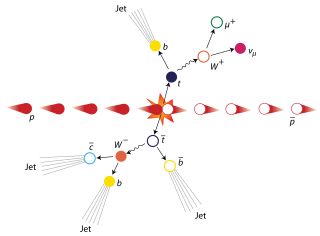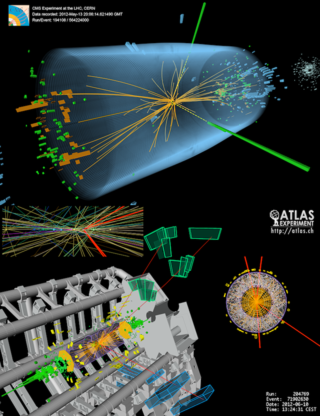Related Research Articles

In particle physics,the electroweak interaction or electroweak force is the unified description of two of the four known fundamental interactions of nature:electromagnetism (electromagnetic interaction) and the weak interaction. Although these two forces appear very different at everyday low energies,the theory models them as two different aspects of the same force. Above the unification energy,on the order of 246 GeV,they would merge into a single force. Thus,if the temperature is high enough –approximately 1015 K –then the electromagnetic force and weak force merge into a combined electroweak force. During the quark epoch (shortly after the Big Bang),the electroweak force split into the electromagnetic and weak force. It is thought that the required temperature of 1015 K has not been seen widely throughout the universe since before the quark epoch,and currently the highest human-made temperature in thermal equilibrium is around 5.5x1012 K (from the Large Hadron Collider).

In particle physics,a Grand Unified Theory (GUT) is a model in which,at high energies,the three gauge interactions of the Standard Model comprising the electromagnetic,weak,and strong forces are merged into a single force. Although this unified force has not been directly observed,many GUT models theorize its existence. If the unification of these three interactions is possible,it raises the possibility that there was a grand unification epoch in the very early universe in which these three fundamental interactions were not yet distinct.

In nuclear physics and particle physics,the weak interaction,which is also often called the weak force or weak nuclear force,is one of the four known fundamental interactions,with the others being electromagnetism,the strong interaction,and gravitation. It is the mechanism of interaction between subatomic particles that is responsible for the radioactive decay of atoms:The weak interaction participates in nuclear fission and nuclear fusion. The theory describing its behaviour and effects is sometimes called quantum flavourdynamics (QFD);however,the term QFD is rarely used,because the weak force is better understood by electroweak theory (EWT).

The Standard Model of particle physics is the theory describing three of the four known fundamental forces in the universe and classifying all known elementary particles. It was developed in stages throughout the latter half of the 20th century,through the work of many scientists worldwide,with the current formulation being finalized in the mid-1970s upon experimental confirmation of the existence of quarks. Since then,proof of the top quark (1995),the tau neutrino (2000),and the Higgs boson (2012) have added further credence to the Standard Model. In addition,the Standard Model has predicted various properties of weak neutral currents and the W and Z bosons with great accuracy.
In a supersymmetric theory the equations for force and the equations for matter are identical. In theoretical and mathematical physics,any theory with this property has the principle of supersymmetry (SUSY). Dozens of supersymmetric theories exist. Supersymmetry is a spacetime symmetry between two basic classes of particles:bosons,which have an integer-valued spin and follow Bose–Einstein statistics,and fermions,which have a half-integer-valued spin and follow Fermi–Dirac statistics.

The top quark,sometimes also referred to as the truth quark,is the most massive of all observed elementary particles. It derives its mass from its coupling to the Higgs Boson. This coupling is very close to unity;in the Standard Model of particle physics,it is the largest (strongest) coupling at the scale of the weak interactions and above. The top quark was discovered in 1995 by the CDF and DØexperiments at Fermilab.

Technicolor theories are models of physics beyond the Standard Model that address electroweak gauge symmetry breaking,the mechanism through which W and Z bosons acquire masses. Early technicolor theories were modelled on quantum chromodynamics (QCD),the "color" theory of the strong nuclear force,which inspired their name.

In the Standard Model of particle physics,the Higgs mechanism is essential to explain the generation mechanism of the property "mass" for gauge bosons. Without the Higgs mechanism,all bosons (one of the two classes of particles,the other being fermions) would be considered massless,but measurements show that the W+,W−,and Z0 bosons actually have relatively large masses of around 80 GeV/c2. The Higgs field resolves this conundrum. The simplest description of the mechanism adds a quantum field (the Higgs field) which permeates all of space to the Standard Model. Below some extremely high temperature,the field causes spontaneous symmetry breaking during interactions. The breaking of symmetry triggers the Higgs mechanism,causing the bosons it interacts with to have mass. In the Standard Model,the phrase "Higgs mechanism" refers specifically to the generation of masses for the W±,and Z weak gauge bosons through electroweak symmetry breaking. The Large Hadron Collider at CERN announced results consistent with the Higgs particle on 14 March 2013,making it extremely likely that the field,or one like it,exists,and explaining how the Higgs mechanism takes place in nature. The view of the Higgs mechanism as involving spontaneous symmetry breaking of a gauge symmetry is technically incorrect since by Elitzur's theorem gauge symmetries can never be spontaneously broken. Rather,the Fröhlich–Morchio–Strocchi mechanism reformulates the Higgs mechanism in an entirely gauge invariant way,generally leading to the same results.
The Alternative models to the Standard Higgs Model are models which are considered by many particle physicists to solve some of the Higgs boson's existing problems. Two of the most currently researched models are quantum triviality,and Higgs hierarchy problem.
The J. J. Sakurai Prize for Theoretical Particle Physics,is presented by the American Physical Society at its annual April Meeting,and honors outstanding achievement in particle physics theory. The prize consists of a monetary award (US$10,000),a certificate citing the contributions recognized by the award,and a travel allowance for the recipient to attend the presentation. The award is endowed by the family and friends of particle physicist J. J. Sakurai. The prize has been awarded annually since 1985.
In physical cosmology,the electroweak epoch was the period in the evolution of the early universe when the temperature of the universe had fallen enough that the strong force separated from the electroweak interaction,but was high enough for electromagnetism and the weak interaction to remain merged into a single electroweak interaction above the critical temperature for electroweak symmetry breaking (159.5±1.5 GeV in the Standard Model of particle physics). Some cosmologists place the electroweak epoch at the start of the inflationary epoch,approximately 10−36 seconds after the Big Bang. Space is subjected to inflation,expanding by a factor of the order of 1026 over a time of the order of 10−33 to 10−32 seconds. The universe is supercooled from about 1027 down to 1022 kelvin. Some theorists suggest that this inflation is permanent,and may have created a universe that includes our parent universe or multiverse. The current concept of the universe has passed debate of the current academic community;however,there remains a conjecture,approximately 10−33 seconds,after the Big Bang. Others place it at approximately 10−32 seconds after the Big Bang when the potential energy of the inflaton field that had driven the inflation of the universe during the inflationary epoch was released,filling the universe with a dense,hot quark–gluon plasma. Particle interactions in this phase were energetic enough to create large numbers of exotic particles,including W and Z bosons and Higgs bosons. As the universe expanded and cooled,interactions became less energetic and when the universe was about 10−12 seconds old,W and Z bosons ceased to be created at observable rates. The remaining W and Z bosons decayed quickly,and the weak interaction became a short-range force in the following quark epoch.
In theoretical physics,the unitarity gauge or unitary gauge is a particular choice of a gauge fixing in a gauge theory with a spontaneous symmetry breaking. In this gauge,the scalar fields responsible for the Higgs mechanism are transformed into a basis in which their Goldstone boson components are set to zero. In other words,the unitarity gauge makes the manifest number of scalar degrees of freedom minimal.

The Higgs boson,sometimes called the Higgs particle,is an elementary particle in the Standard Model of particle physics produced by the quantum excitation of the Higgs field,one of the fields in particle physics theory. In the Standard Model,the Higgs particle is a massive scalar boson with zero spin,even (positive) parity,no electric charge,and no colour charge that couples to mass. It is also very unstable,decaying into other particles almost immediately upon generation.
The 1964 PRL symmetry breaking papers were written by three teams who proposed related but different approaches to explain how mass could arise in local gauge theories. These three papers were written by:Robert Brout and François Englert;Peter Higgs;and Gerald Guralnik,C. Richard Hagen,and Tom Kibble (GHK). They are credited with the theory of the Higgs mechanism and the prediction of the Higgs field and Higgs boson. Together,these provide a theoretical means by which Goldstone's theorem can be avoided. They show how gauge bosons can acquire non-zero masses as a result of spontaneous symmetry breaking within gauge invariant models of the universe.
In particle physics,W′and Z′bosons refer to hypothetical gauge bosons that arise from extensions of the electroweak symmetry of the Standard Model. They are named in analogy with the Standard Model W and Z bosons.
In theoretical physics,a mass generation mechanism is a theory that describes the origin of mass from the most fundamental laws of physics. Physicists have proposed a number of models that advocate different views of the origin of mass. The problem is complicated because the primary role of mass is to mediate gravitational interaction between bodies,and no theory of gravitational interaction reconciles with the currently popular Standard Model of particle physics.
In particle physics,composite Higgs models (CHM) are speculative extensions of the Standard Model (SM) where the Higgs boson is a bound state of new strong interactions. These scenarios are models for physics beyond the SM presently tested at the Large Hadron Collider (LHC) in Geneva.
Tulika Bose is a Professor of Physics at the University of Wisconsin-Madison,whose research focuses on developing triggers for experimental searches of new phenomena in high energy physics. Bose is a leader within the Compact Muon Solenoid (CMS) experiment,a CERN collaboration famous for its experimental observation of the Higgs boson in 2012.

Kevin T. Pitts is an American high energy particle physicist. In addition to his faculty appointment at the University of Illinois at Urbana–Champaign,in 2021 he was appointed chief research officer at Fermilab National Accelerator Laboratory. His research interests have included the CDF experiment and the Muon g-2 experiment at Fermilab.
Graham Kribs is an American theoretical particle physicist at the University of Oregon. He was elected a Fellow of the American Physical Society in 2015.
References
- ↑ "U.S., Naturalization Records 1865-1991" . www.ancestry.com. 1989. Retrieved July 18, 2021.
{{cite web}}: CS1 maint: url-status (link) - 1 2 ORCID. "Nilendra Deshpande (0000-0002-8016-6136)". orcid.org. Retrieved July 18, 2021.
- ↑ "Kanchan Deshpande". The Register Guard . July 17, 2021. Retrieved July 17, 2021.
- ↑ "Nilendra G. Deshpande, INSPIRE". inspirehep.net. Retrieved July 18, 2021.
{{cite web}}: CS1 maint: url-status (link) - 1 2 Csonka, Paul L. (March 20, 2016). "History of the Physics Department" (PDF). Retrieved July 17, 2021.
{{cite web}}: CS1 maint: url-status (link) - ↑ "APS Fellow Archive". www.aps.org. Retrieved July 17, 2021.
{{cite web}}: CS1 maint: url-status (link)